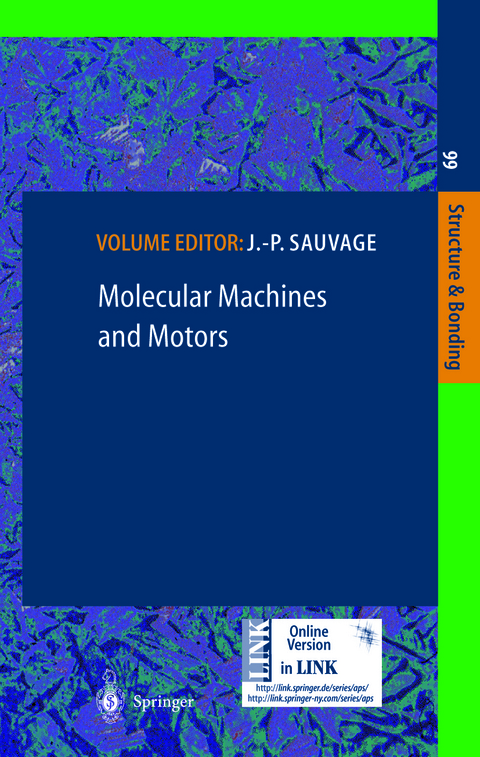
Molecular Machines and Motors
Seiten
2010
|
Softcover reprint of the original 1st ed. 2001
Springer Berlin (Verlag)
978-3-642-07464-6 (ISBN)
Springer Berlin (Verlag)
978-3-642-07464-6 (ISBN)
With contributions of numerous experts
The field of molecules in motion, for which movements and shape changes are triggered and controlled from outside, has been indisputably one of the most rapidly developing areas of the last decade. Clearly, molecular chemists in general are able to elaborate more and more complex species, as beautifully demonstrated by the synthesis of amazingly complicated natural products. For instance, the total synthesis of compounds such as taxol and brevetoxin B represents a formidable tour de force, as does that of many other recent examples. However, most of the time, once the compound has been made, the target has been reached. The synthesis of molecules for which given functions are to be expected and explored once sufficient amounts of the compounds are available, requires the interaction of several fields. The multidisciplinary aspect, involving various methodologies from synthesis to electro and photochemistry, from surface science to spectroscopy and magnetic properties, allows the design and elaboration of molecular objects displaying new functions. Amongst the new functions that chemists want to introduce into their systems, motion is particularly important. In addition, a geometrical change will generally be accompanied by a modification of one or more properties (colour, lumines cence, catalytic properties, etc...) which could be used as a testimony to the motion and also be of practical interest for future applications.
The field of molecules in motion, for which movements and shape changes are triggered and controlled from outside, has been indisputably one of the most rapidly developing areas of the last decade. Clearly, molecular chemists in general are able to elaborate more and more complex species, as beautifully demonstrated by the synthesis of amazingly complicated natural products. For instance, the total synthesis of compounds such as taxol and brevetoxin B represents a formidable tour de force, as does that of many other recent examples. However, most of the time, once the compound has been made, the target has been reached. The synthesis of molecules for which given functions are to be expected and explored once sufficient amounts of the compounds are available, requires the interaction of several fields. The multidisciplinary aspect, involving various methodologies from synthesis to electro and photochemistry, from surface science to spectroscopy and magnetic properties, allows the design and elaboration of molecular objects displaying new functions. Amongst the new functions that chemists want to introduce into their systems, motion is particularly important. In addition, a geometrical change will generally be accompanied by a modification of one or more properties (colour, lumines cence, catalytic properties, etc...) which could be used as a testimony to the motion and also be of practical interest for future applications.
Single Molecular Rotor at the Nanoscale.- Rotary Motion in Single-Molecule Machines.- Molecular Machines and Motors Based on Transition Metal-Containing Catenanes and Rotaxanes.- Molecular Movements and Translocations Controlled by Transition Metals and Signaled by Light Emission.- Molecular Hysteresis by Linkage Isomerizations Induced by Electrochemical Processes.- Switchable Molecular Devices: From Rotaxanes to Nanoparticles.- Molecular-Level Artificial Machines Based on Photoinduced Electron-Transfer Processes.- Computing at the Molecular Level.- Molecular Memory and Processing Devices in Solution and on Surfaces.
| Erscheint lt. Verlag | 6.12.2010 |
|---|---|
| Reihe/Serie | Structure and Bonding |
| Zusatzinfo | X, 302 p. 58 illus. |
| Verlagsort | Berlin |
| Sprache | englisch |
| Maße | 155 x 235 mm |
| Gewicht | 537 g |
| Themenwelt | Naturwissenschaften ► Physik / Astronomie ► Atom- / Kern- / Molekularphysik |
| Schlagworte | Anorganische Chemie • Coordination Chemistry • Electron-Transfer-Process • Elektron-Transfer-Prozeß • Inorganic Chemistry • Koordinationschemie • Macrocyclic Chemistry • Makrozyklische Chemie • Material Science • Materialwissenschaft • Molecule • Nanoparticle • particles |
| ISBN-10 | 3-642-07464-2 / 3642074642 |
| ISBN-13 | 978-3-642-07464-6 / 9783642074646 |
| Zustand | Neuware |
| Informationen gemäß Produktsicherheitsverordnung (GPSR) | |
| Haben Sie eine Frage zum Produkt? |
Mehr entdecken
aus dem Bereich
aus dem Bereich
Buch | Softcover (2024)
Wiley-VCH (Verlag)
CHF 83,85


